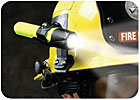
Early last month, volatile dust was blamed for a deadly explosion at a Georgia sugar refinery. At the time of this writing it is not known what ignited the combustible sugar dust. For safety professionals, the fatal blast is another reminder of the importance of being vigilant regarding both the environments that create such hazards and the sources that can ignite them.
In this article we will examine safety flashlights, and how they can protect workers in explosive areas. Six criteria can be used for evaluating a safety-approved flashlight: safety approvals, light and power sources, durability, specialized safety features and warranty.
1. Safety approvals
Safety approvals ensure that flashlights are thoroughly tested so they won’t cause an explosion when the light is activated where flammable materials or gases are prevalent. Such environments include oil refineries, paint warehouses, offshore oil rigs, grain silos, spray booths and other facilities.There are many different types of approvals, and most good industrial safety flashlights meet several different standards. However, an acceptable flashlight should at least be tested and certified by a Nationally Recognized Testing Laboratory (NRTL) to meet standards set forth by OSHA. Some of the major testing bodies include: ETL (Edison Testing Laboratories), FM (Factory Mutual Research) and UL (Underwriters Laboratories).
Each of the three Classes define a level of risk associated with the hazardous area. The risk level is determined by the volatility of the explosive fuel source. The highest risk, Class 1, refers to flammable gases, vapors and liquids. Class 2 encompasses combustible dusts from coal or grain, for example. Class 3 covers ignitable fibers and flyings, which can be found in facilities such as sawmills.
Within each Class are Divisions 1 and 2, which determine the probability of an explosion if the fuel is exposed to an ignition source. Division 1 means the hazard is likely. Division 2 means the hazard is unlikely, though Division 2 areas are still hazardous.
2. Light source
Bulb and beam type are essential criteria for choosing a light. Flashlight bulbs can be a significant source of ignition and must be tough enough to take a fall and not shatter. The most widely used types are incandescent and LEDs (light emitting diodes).Incandescent bulbs use a super-heated tungsten filament inside a vacuum-sealed glass tube to generate light. Flashlight bulb’s filaments are surrounded by gases (most commonly xenon or halogen) to prevent oxidation. Naturally, this increases the chance of an arc and explosion due to the bulb material, internal gases and filament. Incandescent bulbs are less expensive but have a limited lifetime. They can withstand higher wattage and generate significantly more light than LEDs. But higher wattage incandescent bulbs mean bigger energy consumption and poor energy efficiency as most of the energy consumed is turned into heat.
LEDs, on the other hand, are cooler running and more energy efficient. Additionally, they are quickly being adapted to higher wattages, so LEDs will soon rival the brightness of incandescent bulbs. LEDs’ average lifetime usage spans about ten years or 10,000 hours.
LEDs are solid plastic bulbs with an embedded semiconductor that focuses photons or light particles when excited by an electrical current. LEDs are almost impossible to shatter and lack the ignition risk of a heated filament, making them well-suited for use in hazardous areas. With LEDs you won’t need to replace batteries as often, and it’s likely that you will never have to replace the bulb.
Beam type also impacts the brightness, and can make the difference when the lights go out. A beam should be wide enough to cover a significant area, yet focused enough to cut through smoke and particulates that might be in the air.
Most flashlights are purpose-built, so the beam for a firefighter will have different properties than that for an industrial worker.
3. Power source
There are several battery options on the market today, each with trade-offs. Options include:- Disposable batteries offer a longer run time at a lower cost, but they need to be replaced and carried as spares. The main types of disposable batteries include alkaline and lithium.
- Alkaline batteries have a high energy density, long shelf-life and are the most common and cheapest. However, the more expensive lithium batteries can run up to 50 percent longer than any equivalent alkaline and perform better in extreme cold and heat.
- Rechargeable batteries offer greater cost efficiency but shorter run times.
- Nicad batteries were once the most widely accepted rechargeable battery type. The problem is that if the battery isn’t drained completely, “battery memory” issues lead to decreasing charge capacities going forward, and a hastened demise.
4. Durability
Simple as it sounds, if a light is made of flimsy material, the internal components will be extremely susceptible to shocks and falls. Aluminum and polymer are the most common flashlight body types.Aluminum flashlights are the heavier and tougher of the two types. They also feature a less conductive metal, but carry big safety risks if dropped on an open electric circuit. Additionally, they can be dented.
Polymer flashlights (with their non-conductive polymer bodies) carry the least amount of danger in hazardous situations. They can also withstand incredible impact without breaking and, on the whole, are lighter than their aluminum counterparts.
5. Specialized safety features
Of course, with safety certifications, come dedicated safety features. There are several types of features to look for:- Special lamp modules equipped with hydrogen-absorbing pellets convert the residual gas given off of batteries into harmless water vapor.
- Battery polarity guard trays protect against heat generated from improperly installed batteries. They also guard against “outgassing” that occurs when one or more batteries are accidentally reversed.
- One-way umbrella purge valves alleviate internal pressure caused by the natural hydrogen gases a battery emits.
- O-ring seals keep external combustive gases from entering the body of the flashlight.
- Photoluminescent lens rings that glow like a beacon allow the user to find the light even in the dark when the light is switched off.



